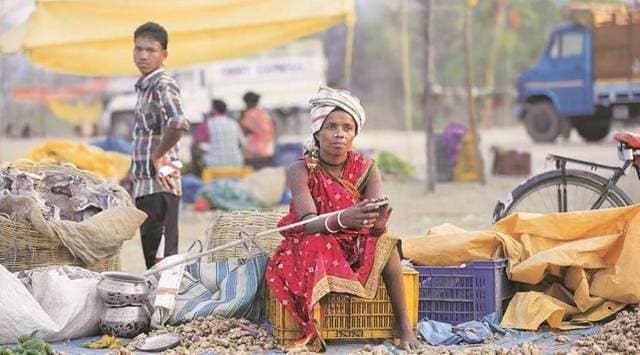- India
- International
People of denotified tribes continue to bear the burden of an unjust colonial past
Certain communities such as the Denotified Tribes (DNTs), which have a history of persecution by the criminal justice system, are targeted under specific laws and legal provisions.
 A woman belonging to the denotified tribe sits on top of a vegetable basket at a road in Delhi. (File/ (Express photo by Abhinav Saha)
A woman belonging to the denotified tribe sits on top of a vegetable basket at a road in Delhi. (File/ (Express photo by Abhinav Saha)In August, the National Crime Records Bureau (NCRB) released the annual Prison Statistics Report for 2019. This compilation provides demographic information on prison inmates for administrative categories such as age, gender, religion and caste. It has consistently highlighted to lawmakers the overrepresentation of marginalised communities such as the Scheduled Castes (SC), Scheduled Tribes (ST) and Other Backward Classes (OBC) in our prison population. However, the administrative categories of SC/ST/OBC –relied on for the identification of inmates’ social location — are too broad. They minimise and invalidate the probing cruelty of the criminal justice system against specific communities within these heterogeneous caste categories. Official data must be further disaggregated to help shed light on the persecution of certain marginalised communities such as the Denotified Tribal Communities.
A closer look at the prison population is likely to tell us that certain communities such as the Denotified Tribes (DNTs), which have a history of persecution by the criminal justice system, are targeted under specific laws and legal provisions. We argue that viewing the problem of overrepresentation of DNTs in the prison population through the lens of policing, would bring to light the targeted persecution of marginalised communities
Twenty-year old Rakesh Pardhi, a farmer from the DNT Pardhi community, was arrested in May for illegal possession of raw country liquor and charged under section 34 (2) of the MP Excise Act in the first week of April. A first-time offender, he suffered from tuberculosis, placing him at a higher risk of suffering complications from COVID-19. Rakesh also qualified for interim bail, and given his affliction, that was even more pertinent. However, he was incarcerated for nearly three months.
Rakesh’s case is no exception. It reflects the historical oppression of Denotified Tribes (DNT) under the criminal justice system through anti-poor, casteist legislations such as the Excise Act.
During colonial rule, the Criminal Tribes Act, 1871 vilified several nomadic tribes as hereditary criminals “addicted to systematic commission of non-bailable offences”. The prevailing caste system’s rationale was used for such categorisation of these communities. Their social practices and physical attributes were relied on as evidence of their criminality. The DNT communities were subjugated to state surveillance, control and violence in myriad ways.

The Criminal Tribes Act, 1871 was repealed in 1952, following the adoption of the Indian Constitution. However, many denotified tribes continue to face the ‘taint of criminality’ — the police, courts and society continue to view them as criminals. Narratives of genetic criminality have been replaced with narratives of economic need, group immorality, compulsive indiscipline or addiction to narcotic substances. They are default suspects in cases of theft and dacoity — indiscriminate detention, arrest without warrant, recording of photographs and fingerprints for surveillance and custodial torture continue to be methods practiced by state agencies against these communitites.
These communities also find their traditional occupations criminalised through excise laws, wildlife conservation laws, cattle slaughter prohibition laws — members of DNT communities constitute a majority of people prosecuted under these laws. They are targeted in the garb of maintaining “public order,” regularly externed and made to sign bonds for “good behaviour”.
Yet the extent of this drastic and disparate impact of criminal law on denotified tribes remains undocumented. These communities are first marginalised in the law, and at a second level completely invisibilised in society. This is exemplified by the fact that there is no official data on the total population of denotified, nomadic and semi-nomadic tribes. Despite their unique socio-cultural locations in Indian society, they are administratively categorised as SC, ST, OBC — even placed in the general category in several states. The unique nature of their suffering in the criminal justice system is erased.
In making a small step towards documenting the experiences of DNT communities with the criminal justice system, we studied arrest records under various laws in Madhya Pradesh during the lockdown to map the socioeconomic locations of the individuals policed. Informal estimates also suggest that Madhya Pradesh is home to between 50-60 lakh members of denotified, nomadic and semi-nomadic tribes. This means that they comprise between 8 to 12 per cent of the state’s population.
Our study of 1,281 arrests under the excise laws identified 355 (27.71 per cent) persons from the SC community, 303 (23.65 per cent) from the ST community, 265 (20.69 per cent) from the OBC community, 130 (10.15 per cent) from the DNT community, and 41 (3.2 per cent) from the Muslim community.
Another significant finding was of 139 (10.85 per cent) women being arrested under the excise laws. Of the 103 women with identifiable surnames, 41 (39.8 per cent) belonged to DNT/Nomadic communities — mostly Kuchbandiya, Kanjar communities — and 59 (57.3 per cent) belonged to other SC, ST and OBC communities. The proportion of women within the total number of arrested persons is low, but even within them, DNT women were overrepresented in excise cases. The narrative of born or inherent criminality is deeply intertwined in constructing the category of the “DNT woman” as a criminal. It has also often been used to legitimise gender-based violence against women from DNT communities.
The proportion of DNT representation for all offences examined in our study is an underestimation given that we relied on the last name of the accused person to identify them as a DNT member. Several DNT communities, like other Bahujan communities, resort to concealing their identity by adopting caste neutral last names in hopes of escaping caste-based violence and discrimination. While the adoption of a caste neutral surname may enable some DNT communities to assimilate and evade invasive social surveillance and administrative enumeration, it does not necessarily translate to an escape from the police and the criminal justice system’s systemic oppression.
Every year, hundreds of people from the Pardhi community in Bhopal, Raisen and Sehore districts of Madhya Pradesh, suffer caste-based violence at the hands of both the police and dominant caste groups. This includes harassment, torture and mob-lynching. The Pardhi community, a traditionally forest dwelling Adivasi community, has no recourse under the Scheduled Castes and Scheduled Tribes (Prevention of Atrocities) Act, 1989 because the community which has tens of thousands of people in these districts were removed from the Constitutional List of STs in 2002. No reason was given for this exclusion. The community continues to be classified as ST in several other districts of the state and, oddly even, SC in some districts. The denotification also resulted in the denial of access to welfare programmes tailored for STs in the State.
The politics over inclusion into the administrative categories of SC, ST and OBC remains highly contested. A major aspect of the exclusion of DNT communities remains the absence of any formal record of their existence. Therefore, a decennial census data that records the existence of these communities is crucial. In 2011, when the fourth Socio Economic and Caste Census (SECC) was conducted, around 46,73,034 distinct caste names emerged from the report. This data has however been withheld by the government. It was the first exercise to count the number of OBCs after 1931. This data is also crucial in identifying various groups given the dynamic nature of this category, particularly for DNTs whose history of oppression has been subsumed by this category. Every year, State Governments including that in Madhya Pradesh promise a census of DNT and Nomadic communities, but fail to deliver.
Perhaps most importantly, the availability of disaggregated data would enable highlighting the persistent narrative of criminality that follows members of DNT communities. It would be the first step towards recognising, and dismantling the invisibilised historical oppression and targeting by the criminal justice system that mars the lives of these communities.
The writers are associated with the Bhopal-based Criminal Justice and Police Accountability Project
40 Years Ago
EXPRESS OPINION
Best of Express

More Explained
Apr 16: Latest News
- 01
- 02
- 03
- 04
- 05








































